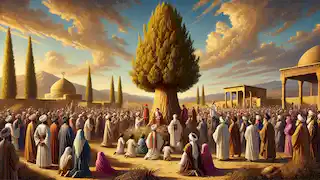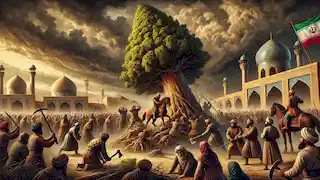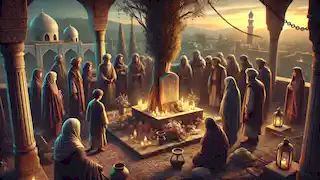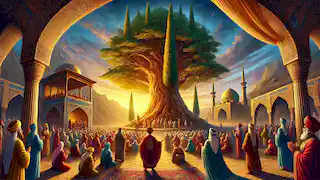The ancient lands of Persia are steeped in tales of mysticism, heroism, and divine intervention, but few are as enchanting as the story of the Sacred Cypress of Kashmar. Standing tall and revered, the cypress held both symbolic and spiritual significance to the people of Iran, weaving a tale of faith, sacrifice, and resilience. This legend spans centuries, touching on themes of loyalty, devotion, and a powerful respect for nature. It is a story not just of a tree but of a nation, of a people’s identity entwined in its branches and roots. Our journey through this ancient tale will reveal the mystical importance of the Sacred Cypress and why, even after its fall, its legacy endures. Long before the emergence of vast empires and dynasties, when Persia was a land of isolated settlements and modest communities, the people were bound by their reverence for nature and the forces of life. At the heart of their beliefs lay a profound connection with the land and its symbols—none more prominent than the Sacred Cypress of Kashmar. According to legend, the tree was no ordinary cypress. It was said to be a divine gift from Zoroaster, the prophet who founded Zoroastrianism, one of the oldest monotheistic religions in the world. Zoroaster, guided by visions from Ahura Mazda, the supreme god of Zoroastrianism, traveled across the arid lands of Persia, preaching his message of truth, order, and purity. As he walked through the deserts and mountains, his followers gathered, their hearts swayed by his words and wisdom. One day, Zoroaster found himself in the village of Kashmar, a settlement nestled at the edge of the desert with little to shield it from the harsh winds and blistering heat. The villagers, deeply moved by Zoroaster's teachings, begged him to stay and protect them from the harsh forces of nature. Zoroaster, touched by their plea, promised them a symbol that would represent strength, resilience, and the eternity of the spirit. He reached into the depths of his robe and, with a quiet prayer, produced a small sapling—a cypress tree. He planted the sapling with his own hands, blessing it to grow tall and strong. Under his guidance, the villagers nurtured the tree, and it flourished beyond expectation. It grew taller than any tree they had ever seen, and its branches stretched towards the sky as though reaching for the heavens. Its roots sank deep into the earth, holding the very soil together and providing a sanctuary of shade for the people. The tree grew not just in stature but in legend. The Sacred Cypress became a beacon of hope, a shrine for worship, and a symbol of unity for the people of Kashmar. The Zoroastrian priests declared it a holy site, a living testament to the power of Ahura Mazda and the purity of Zoroaster’s teachings. Each year, pilgrims from far and wide would make the arduous journey to Kashmar, seeking the blessings of the Sacred Cypress and paying homage to Zoroaster’s legacy. The stories surrounding the tree became the foundation of many legends. It was said that the tree’s roots reached deep into the earth, connecting it to the source of divine wisdom, while its branches extended towards the sun, gathering strength and enlightenment. Those who touched the tree felt a surge of energy and clarity; those who prayed beneath its boughs claimed to receive visions and guidance from the heavens. As time passed, the tree's reputation spread far beyond Kashmar, capturing the imaginations of kings and emperors. For the common folk, it was a source of divine protection, while the rulers of Persia saw it as a testament to their nation’s strength and connection to the divine. Yet, as is often the case, the tree’s fame attracted not only admiration but also envy and greed. Centuries after the tree was first planted, Persia came under the rule of King Manuchehr, a powerful monarch known for his ambition and desire to possess all things rare and remarkable. When he heard of the Sacred Cypress of Kashmar, he became captivated, imagining it as a trophy for his palace grounds. He envisioned the tree standing within the gardens of his capital, a living symbol of his dominion over all of Persia and a testament to his greatness. King Manuchehr sent a decree to the priests of Kashmar, ordering them to uproot the tree and deliver it to his palace. The priests, horrified by the king’s demand, pleaded with him to reconsider, explaining that the tree was sacred, a gift from Zoroaster himself, and that removing it would be a blasphemous act. But Manuchehr’s pride was unyielding. He viewed the tree as a symbol of power rather than spirituality, and he would not be swayed by the entreaties of priests or villagers. The people of Kashmar, hearing of the king’s intentions, gathered around the tree day and night, forming a protective circle, vowing to defend it at all costs. They believed that as long as the tree stood in their village, it would protect them from the king’s wrath. But Manuchehr was undeterred. He dispatched soldiers to forcefully remove the tree, causing an uproar among the people. The king’s soldiers arrived in Kashmar with axes, shovels, and a team of oxen to pull the massive tree from its place. The villagers, helpless against the armed forces, watched in horror as the soldiers hacked at the roots, severing the tree from the earth. It took several days of grueling labor, but at last, the Sacred Cypress was uprooted, its branches sagging as though in sorrow, its roots exposed to the harsh desert sun. As the soldiers prepared to transport the tree, a dark cloud loomed over Kashmar, and a terrible storm struck the village. The villagers saw it as a sign of divine anger, a warning from Ahura Mazda. Thunder cracked across the sky, and rain poured down, drenching the land as the people wept for their fallen protector. Despite the warnings, the soldiers pressed on, determined to complete their mission. They bound the tree with ropes and harnessed the oxen to carry it. The journey was arduous, with the weight of the tree slowing their progress to a crawl. The tree seemed to resist, its branches tangling in rocks and its roots catching on the earth as though refusing to be taken. The king’s soldiers struggled for weeks to transport the cypress to the capital, but every mile seemed to bring a new misfortune. The oxen fell ill, the wheels of their carts shattered, and the soldiers themselves began to suffer strange ailments. Some whispered that the tree was cursed, that it was punishing them for disturbing its sacred home. Yet, King Manuchehr’s orders were absolute, and the soldiers dared not return empty-handed. Meanwhile, back in Kashmar, the people mourned the loss of the tree. Their village seemed barren without it, and the spirit of the place felt as though it had withered with the cypress’s absence. Some villagers swore they could still hear the whispers of the tree in the wind, a lament for its severed roots and broken branches. As the soldiers neared the capital, they encountered their final obstacle. The ground trembled, and a violent earthquake tore through the land, cracking the earth and sending boulders crashing down upon the procession. In a moment of terror, the soldiers realized that the tree, even in death, was not to be moved from its rightful place. Amid the chaos, the tree was lost to the depths of a chasm that had opened in the earth, swallowed whole by the land it had once called home. Word of the tree’s fate spread swiftly, reaching King Manuchehr himself. When he learned of the disaster, he was furious, blaming his soldiers for their failure. But soon, whispers began to circulate in the royal court, tales of the Sacred Cypress’s power and the wrath of Ahura Mazda. The king, fearing the divine retribution that might follow, abandoned his plans to claim the tree, and instead, ordered his priests to perform rituals to appease the gods. In Kashmar, the villagers took solace in the belief that their sacred tree had returned to the earth, that its spirit remained with them, protecting their land from beyond the physical realm. They marked the place where it had once stood with a shrine, a small but steadfast monument that would remind future generations of the Sacred Cypress and the lessons it had imparted. Though the tree was gone, its legacy endured, growing even stronger in its absence. The people of Kashmar told and retold the story, passing it down through the generations. They spoke of the power of nature, of the reverence owed to the divine, and of the resilience of the human spirit. The Sacred Cypress of Kashmar became a symbol of the unbreakable bond between humanity and the earth, a lesson in humility and respect for forces greater than oneself. The legend of the Sacred Cypress spread far beyond the borders of Persia, reaching the far corners of the world. Scholars, poets, and travelers from distant lands came to Kashmar, eager to hear the tale and pay homage to the site where the great tree once stood. Its story became immortalized in poems, songs, and works of art, each piece capturing a fragment of the tree’s spirit. To this day, the memory of the Sacred Cypress lives on in the hearts of the people of Iran, a symbol of strength, unity, and respect for the natural world. In Kashmar, they say that on quiet nights, when the wind rustles through the trees, you can hear the whisper of the Sacred Cypress, a reminder of a time when a single tree held the spirit of a nation.Chapter One: The Gift of Zoroaster
Chapter Two: The Growth of a Legend

Chapter Three: The Desire of King Manuchehr
Chapter Four: The Tragic Uprooting

Chapter Five: The Curse of the Sacred Tree

Chapter Six: The Legacy of the Sacred Cypress

Epilogue: The Spirit of the Cypress Lives On
The Story of the Sacred Cypress of Kashmar
Reading Time: 9 min

About Story: The Story of the Sacred Cypress of Kashmar is a Legend Stories from iran set in the Ancient Stories. This Dramatic Stories tale explores themes of Nature Stories and is suitable for All Ages Stories. It offers Cultural Stories insights. A tale of devotion, defiance, and the divine bond between a people and their sacred tree.


















